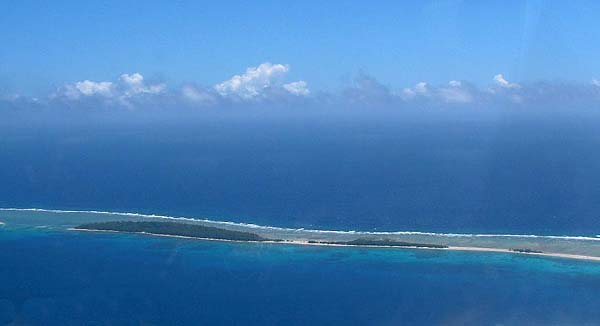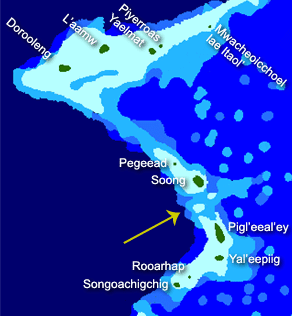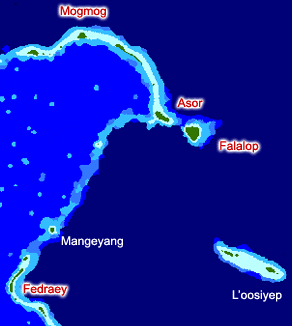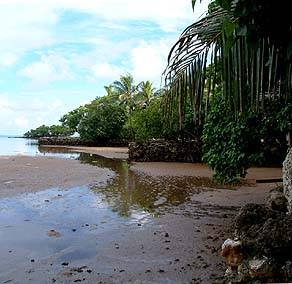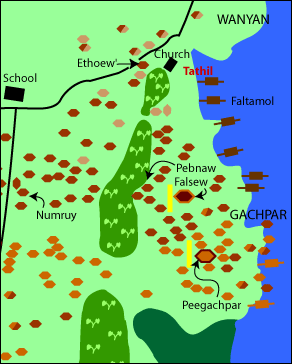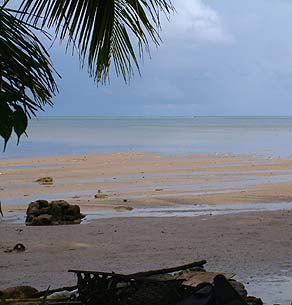 |
 |
 |
|||||
|
|
|
|
|
|
|
|
|
|
|
|||||||
| |
|
|
|
"In the history of this place, our religion, they say that the first person here was a lady from Yap," relates Philip Nery. "She came out from that part of the island, Gachpar, because she didn’t like the way that her family treated her in Yap. When they had turtles, they gave her only the bad part of the turtle." “Yongl’aab had only one daughter,” Pitmag recounts. “Her name was Liomarer. And she always went to the hill and worked on a potato field, planting potatoes."
|
||
| |
||
"And one day she was working on that field, and when she was up there on the hill she looked over to Gachpar, and she saw smoke coming up from Numruy, her home place. And she said, ‘Oh, what a lucky day, I’m going to eat some turtle meat. They have already cooked the turtle.’ "So after work she came to the house and she found a basket of meat hanging up near her room. She cut this down and opened the basket, where she found a piece of turtle meat. It was one of the turtle’s arms or legs in the basket. "She was very upset when they selected that part to be her share. She’s supposed to get the nice part of the turtle, the breast meat. Instead, they left the arm part for her. So she was very upset, crying and crying. And then she came to the sea shore and tried to get away from Yap, because she was upset about what they put up for her."
|
|
|
"She made magic," Philip continues: "she took one coconut shell, filled it with sand and made magic and sprinkled the sand on the ocean, and it became sand bars. Then she walked on the sand bar and when it ended, she sprinkle some more. Until she came this far. “She was just dropping this sand and she walked on it,” Hosay says. “Just imagine a small coconut shell filled with sand, and the distance between Yap and here—a hundred miles—but there was enough sand for her to walk on until she arrived here. That’s the legend." "At that time, it was like she was half-human and half ghost," Alphonso adds, "because she walked on the water all the way up to where Ulithi is now located."
|
“And in the channel there between Pigl’eeal’ey and Soong, there is a wide spot there. It’s close to the reef on the northern end. And during the night time, when you go down on the canoe, there’s a marker where we follow. On one side of the wide spot in the channel. And they say that that marker is the mark for her stone, the stone for her house that she was putting up from there.” "When she no longer had Yap in sight," Pitmag continues, "then she dropped that sand all over with a little magic. When she opened her eyes, there were some small islands all over the area, which is very definitely true. So she stayed on one of them, which is Mogmog." “Filtey came first to Mogmog,” Stanley says. “She moved from here to L'oosiyep, thinking that if she would relocate to another area, she might have a better view of the lagoon."
|
|
|
|
|
“So she stayed there alone," Pitmag says, "and then, I don’t know how, what she took or used or ate, but finally she got pregnant and gave birth to a boy.” “Filtey was Liomarer’s son,” Yaad explains, “and Liomarer, the mother, built a small canoe for Filtey, and gave it to him. This small canoe, he cannot ride it, he can only sail it in the sea as a toy. And she told him he can sail it anywhere but not towards the West because Yap is there, her island. And she doesn’t want her son to go back to Yap because she was mad about the part of the turtle they did not give her. “And then the boy always kept that in mind,” Pitmag continues. “And then one day when he was playing with the canoe, all of sudden the canoe starts sailing away from Ulithi, westerly.”
|
||
|
|
||
“He could not grab the canoe,” Yaad says, “so he kept on swimming after the canoe until they got into Gagil, to a place between Gachpar and Wanyaan that we call Tathil. “There, all the kids from Gachpar and Wanyaan were playing," Pitmag notes, "taking their canoes and sailing them back and forth in between the two villages. So Filtey joined the game. But he always won the game.” “Going to Wanyaan, he won—that means going to the North,” Yaad relates. “Going toward Gachpar, that means going to the South, he won. Every way they went, he won. Pitmag says, “The kids from Gachpar and Wanyaan said, ‘look at his guy, do you know where he comes from?’ And then they broke his canoe. And beat him. And then ran away from him and left him there."
|
|
|
"He was crying, and while he was crying he sang a song, calling his mother: ‘Oh Liomarer, Oh Liomarer, why did you tell me, your mother is from Yap, and your father is from Yap, and they keep on beating me? Oh Liomarer, Oh Liomarer…’ That’s what the crying is saying.” “He kept on singing this while he was crying,” Yaad says, “and some of the men of the Men’s House listened, they said, ‘Hey, there is something wrong with that canoe-racer. You want to get that boy,’ because they heard that he was calling his mother, which is Liomarer. And the mother is related to them. “So they went and tell him to come at the house, and they keep on asking him, ‘Who are you?’ ‘My name is Filtey.’ ‘What is your mother’s name?’ ‘Liomarer.’ ‘Where is she?’ ‘She’s up there,’ and he point to the East. ‘And where do you come from?’ ‘I came from there.’ ‘Where?’ ‘Ulithi,’ ‘Oh, is there any island, or land over there?’ – ‘Yes, that’s where I came from.’ ‘Oh, can we go with you?’"
|
| "And he said, ‘No, you can not go with me.’ ‘Why? We want to meet your mother.’ ‘She told me if I bring people, people from here to her, and when I go, she will die.’ ‘Oh, no that’s not true. That’s a lie.’ “But the mother had told him, when he brings people from Gachpar to Ulithi, and when he gets close to the land, if he sees a ripe banana—even a small banana but it’s already ripe—then that’s the sign that she has died. "But the people of Gachpar village didn’t listen, they kept on pushing to go with him to Ulithi. So they went. And when they got close, ALL the bananas on the island were ripe. All of them, even the small ones, ripe, all of them. And the leaves of the bananas had turned yellow. And Filtey cried. "‘Why you are crying?’" they asked. “‘I’m crying because I know my mother has passed away, like she told me. But I’m not going to rush up here.’"
|
|
| |
|
"They came on shore and found the mother had died. So they took the mother to a place where the ladies stay, which is the Women’s House. That’s where they buried the body. And it stayed there. And that’s the beginning of traveling between these two islands. Filtey used to come to Gachpar and back to Ulithi, and after that, many people were coming from many places, so they started a population in Ulithi. And this is the beginning of sawey."
|
||
|
|
||
|
|
|
|
|
|

|
| Ulithi Home | Map Library | Site Map | Pacific Worlds Home |
|
|
|
|

|
|
|
||
|
Copyright 2003 Pacific Worlds & Associates • Usage Policy • Webmaster |
